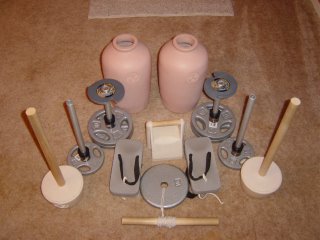Many people who study "traditional martial arts" have a correct emphasis on kata, or forms. These forms reinforce proper biomechanical positions in the learner (which is why having a teacher who can ensure the student is doing it properly is important) and contain much of the "secrets" of a system. Of course, these are not really "secret", requiring only time and practice to find them out. Yet many of those studying traditional martial arts neglect another aspect of their training, which is the supplemental conditioning of the body. Ironically, many of the much more sport-oriented are not lacking in the exercise department (however misguided much of their combative emphasis is). They do tend to focus more on simply increasing the attributes of overall fitness such as aerobic endurance or pumping iron rather than specifically tailoring it to the needs of a quick and dirty fight. Don't get me wrong, it is very good to have strong arms and legs, but simply training for strength and speed will only get you so far.
Traditional martial arts practitioners on Okinawa knew the importance of training not only in the fighting principles and concepts, but also in simply training the body so it is strong enough to perform manuevers correctly and healthy enough to do it for the rest of their lives. Note this is not the same as simply relying upon brute force to achieve your ends. There is a big difference in mindset between those who train simply to "stay in shape" and those who train with the mindset of preparing for combat. Sadly, such a phrase is repeated so often by so many that it comes off as sounding rather trite. But it's true.

One of these ways was by striking the makiwara. Rather than being simply a method of toughening up your knuckles by striking a post covered in straw, it is actually meant to teach proper technique. The board should be flexible to have some "give". Otherwise, you are just harming your joints. Even still, a makiwara tends to tell you rather quickly if you are doing something wrong. A common critique of karate is that it involves people simply waving their hands in the air and punching the space in front of them. They fail to realize we the whole range that karate training encompasses. And before I sound like a cheesy advertisement, on to the next piece of equipment...

Another type of training was the use of various weights that specifically emphasized gripping strength. They are great for strengthening the fingers, the hand, the wrists, the forearms, the shoulders, trapezius muscles (and others...I'm not that great with anatomy). Great for striking or grappling and do a better job at targeting martial arts-specific muscles.
These are my set of traditional (or traditional-type) weight training devices. The jars, weight hammers, weighted sandals, and stone lock are from the store of Kyoshi Kevin Roberts. The two other sets are from BushiPower.com, which I enjoy using because it is easier to customize the weight-load by being able to use different plates. I've noticed significant increases in grip strength, including whenever I have to carry in a load of groceries...

These are three large paint buckets, one with corn, one with pea gravel, and one with sand. I ended up getting these after taking the advice of Hanshi Ron Lindsey, an old school Shorin Ryu teacher. I had the opportunity to attend one of his seminars here in Texas and wanted his input on the type of training devices he used. He used much of the above (and some more), but he also recommended the buckets. Striking the corn and pea gravel with various types of finger strikes strengthens the surface of the fingers while striking the sand strengthens the joints as it only gives to a certain point. Also, digging deep into the corn and opening and closing your hand strengthens the muscles and connective tissue used in opening the hand, which is something most people do not work on. This aids especially in finger strikes as well as finger strength in general.

I recently starting to play piano again after a long leave of absence. A large part of my motivation was simply wanting to play the piano again. Another part was ensuring coordination in both hands and to keep working the fingers...don't laugh, it's true.
And of course, the benefits of all this is not limited to martial arts. I was playing basketball with a group of friends the other day when a rebound bounced hard off the rim and right into my fingers with a loud "thwack". People beside me winced in sympathy pain and one of them said I probably sprained a finger. I'm convinced I probably would have, but my fingers were absolutely fine...a cheesy example, but one that is true...
Technorati: karate Martial Arts martial-arts Self Defense fighting
2 comments:
Where did you get that makiwara? I want one!
I wonder how many people have seriously injured themselves on the makiwara. I'm guessing most Westerners don't know the proper way to use this traditional piece of equipment. Chojun Miyagi (among others of his time, I'm sure) could puncture a metal can with a toe-kick. You don't see too much of that today!
Post a Comment